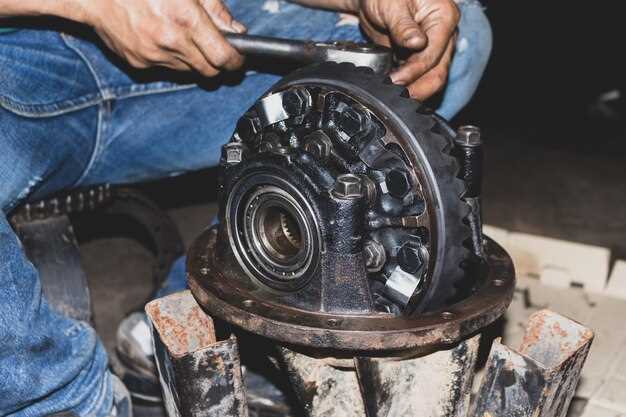
The driveshaft is a critical component in the drivetrain of any vehicle, responsible for transferring power from the engine to the wheels. Ensuring its optimal functionality is crucial for maintaining vehicle performance and safety. Regular inspection of the driveshaft can prevent unexpected failures and prolong the lifespan of the vehicle. Understanding the proper techniques for driveshaft inspection is essential for both automotive professionals and enthusiasts alike.
One of the key aspects of driveshaft inspection involves examining its rotation dynamics. Observing how the driveshaft rotates under different conditions helps in identifying potential issues such as vibrations, imbalances, or signs of wear. Properly inspecting the driveshaft not only involves visual checks but also necessitates a keen understanding of the mechanical interactions that occur during rotation.
In this article, we will outline the essential steps for conducting a thorough driveshaft inspection. We will delve into various techniques, tools, and methods that can be employed to assess the condition of this vital component. By following these steps, vehicle owners can ensure that their driveshaft is in excellent condition, ready to handle the demands of everyday driving.
Assessing Driveshaft Alignment and Clearances

Proper assessment of driveshaft alignment and clearances is crucial for maintaining the overall performance and longevity of a vehicle’s drivetrain. Misalignment can lead to excessive vibration, increased wear, and potential failure of the driveshaft and connected components.
Start the alignment check by visually inspecting the driveshaft for any noticeable bends or deformities. A straight driveshaft is essential for proper operation, as any warp can result in poor alignment. Utilize a measuring tool to confirm that the driveshaft is correctly positioned relative to the axles and transmission.
Next, assess the angular alignment of the driveshaft. This can be measured with a protractor or alignment tool. Ideally, the angles should be within the manufacturer’s specifications, commonly ranging from 1 to 3 degrees. Excessive angles may indicate misalignment, necessitating adjustments to the mounting points or the driveshaft itself.
Clearances between the driveshaft and surrounding components must also be evaluated. Check for adequate space to prevent contact during operation, especially when the vehicle is under load or in motion. Any potential obstructions should be corrected to avoid wear or damage over time.
Finally, during the inspection, ensure that all mounting hardware is secure and in good condition. Loose or damaged brackets can lead to misalignment and affect the driveshaft’s performance. Regular inspections focused on alignment and clearance will contribute to a smoother ride and extend the lifespan of the driveshaft.
Identifying Signs of Wear and Damage Through Rotation

One of the most effective methods for assessing the condition of a driveshaft is through careful observation of its rotation during operation. As the driveshaft rotates, it undergoes various stresses that can reveal underlying issues.
Visual Inspection: While the driveshaft is in motion, look for any irregularities in its surface. Signs such as cracks, dents, or warping can indicate structural weaknesses that need immediate attention. These imperfections can become more pronounced as the driveshaft continues to rotate.
Vibration Analysis: Excessive vibration during rotation can be a clear indicator of misalignment, imbalance, or wear. Observing the driveshaft for unusual shaking or wobbling can help identify problems that may not be visible to the naked eye. If vibrations occur, it is essential to investigate further.
Noise Assessment: Listen closely for any abnormal sounds that arise while the driveshaft is rotating. Grinding, clattering, or unusual thumping noises may signal that bearings or universal joints are deteriorating. Such auditory cues are crucial for diagnosing potential failures in the driveshaft’s components.
Heat Inspection: Monitoring the temperature of the driveshaft during rotation can also provide valuable insights. If a specific section feels excessively hot, it may indicate friction due to worn bearings or insufficient lubrication. High operating temperatures can accelerate deterioration and lead to catastrophic failures.
In summary, by closely examining the driveshaft during its rotation, technicians can identify several critical signs of wear and damage. Addressing these issues promptly can prevent more significant problems and ensure the longevity of the vehicle’s drivetrain system.
Utilizing Tools for Accurate Driveshaft Measurement
Accurate measurement of a driveshaft is crucial for maintaining optimal vehicle performance and ensuring safety. Utilizing specialized tools can significantly enhance the precision of the assessment process. One of the primary tools employed is a caliper, which allows for precise measurement of the driveshaft diameter. This ensures that the shaft fits correctly within housing and mounts, minimizing the risk of vibration and wear.
Another essential tool is the dial gauge, which is used to measure the runout of the driveshaft during rotation. This tool helps identify any bending or imbalance in the shaft, which can lead to severe mechanical issues if left unaddressed. During inspection, the driveshaft is rotated, and the gauge records any deviations from a true circular path, providing vital data for correction.
Torque wrenches are also critical, especially when checking the torque specifications on bolts and fasteners that secure the driveshaft. Proper torque ensures that all components remain tightly secured during operation, preventing any potential failures resulting from loose parts.
In addition, specialized software can assist in analyzing data collected from these measurements. This software often includes features for simulating driveshaft behavior under various conditions, allowing technicians to predict potential issues before they arise.
Lastly, maintaining tools in optimal condition is essential for guaranteeing measurement accuracy. Regular calibration of measuring devices ensures reliability and precision, ultimately leading to well-informed decisions regarding driveshaft maintenance and replacement.



